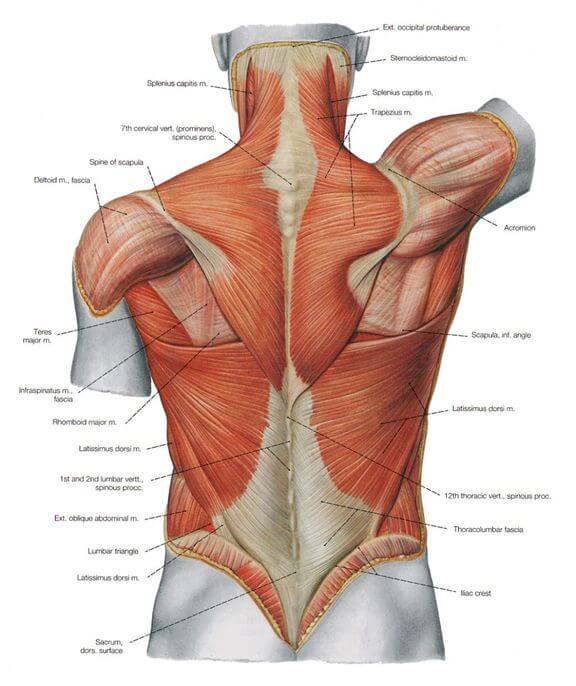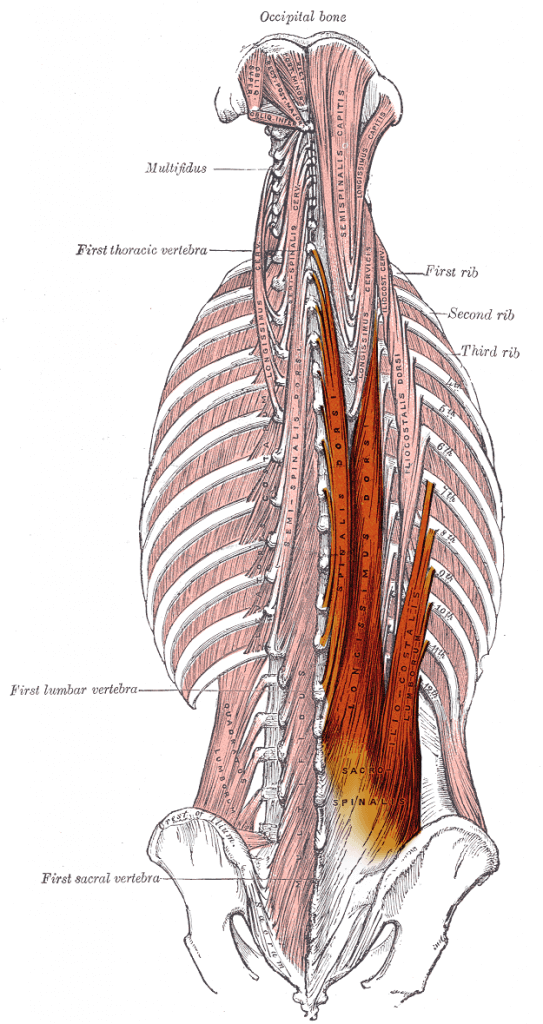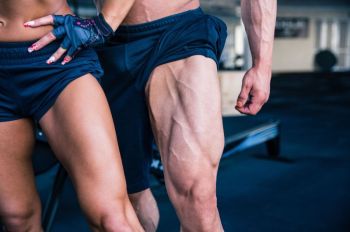Not so long ago, I struggled to get the type of back that I really wanted.
I had tried many things, too.
High reps. Low reps. These exercises. Those exercises. One session per week. Three sessions per week.
But something was missing. It all just wasn’t enough and I didn’t know why.
Well, fast forward to today and here’s where I am now:

I wouldn’t say I’m ready to win a bodybuilding show, but I did finally figure out how to get a back I can be proud of.
And in this article, I’m going to show you how I did it, and how you can follow in my footsteps.
The proof will be in the pudding, too. Follow the 30-day workout routine I lay out below, and your back will get bigger and stronger.
I have to warn you, though—it’s not going to be easy.
You can’t get a wide, thick, and powerful back by popping some pills and powders and doing some pullups and chinups.
So if you’re looking for “weird tricks” or “workout hacks,” then this isn’t for you.
If, however, you’re ready to learn the simple science of building a big back, and if you’re ready to put in some work, then keep reading.
Table of Contents
Understanding the Anatomy of the Back

Let’s start by reviewing the muscles that we want to develop.
The bulk of the back is made up of several muscles:
- Trapezius (traps)
- Rhomboids
- Teres major and minor
- Infraspinatus
- Latissimus dorsi (lats)
- Erector spinae (iliocostalis, longissimus, and spinalis muscles)
The upper portion is referred to as the thoracic spine, which includes the trapezius, rhomboids, teres muscles, infraspinatus, and lats.
Here’s how it looks:

And the lower portion is referred to as the lumbar spine, which is mainly the erector spinae muscles shown here:
 Now, as far as back training goes, here’s the brass ring we’re striving toward:
Now, as far as back training goes, here’s the brass ring we’re striving toward:
- Well-developed traps that form the centerpiece of the upper back.
- Rhomboids that create deep “valleys” when flexed.
- Wide, long lats that give us the V-taper we all love.
- Well-developed teres and infraspinatus muscles that pop.
- Thick erector spinae that turn the lower back into a “Christmas tree.”
Here’s another snapshot of where I’m at with all this:
My lats are still a work in progress (hence the standing upright pushdowns in the video), but all in all I’m pretty happy with where I’m at.
So, if that’s the goal, how do you get there?
Keep reading to find out.


Back Building 101
If you don’t have the back you want, you’re probably making one of two big mistakes:
1. Focusing on the wrong exercises.
You probably spend too much time on machines and isolation exercises and far too little time on compound exercises like the deadlift and barbell row.
2. Doing too much high-rep “pump” training.
If you train more to get a pump than to get strong, you’re always going to have an underwhelming physique.
I’m not judging, though.
I made these mistakes (and many more) for years, and while I did build some muscle along the way, my back (and everything else, really) eventually stopped responding.
I hit a plateau and had no idea what to do about it.
Well, as you’ve seen, I’ve since sorted it all out, and the most important lessons I learned were:
- Do a lot of compound movements.
- Do a lot of work with heavy weights (80%+ of one-rep max).
In terms of back workouts, that means your bread and butter is heavy barbell and dumbbell pulling, and your dessert is supplementary work like lat pulldowns and chinups.
Once I started training that way, I finally started seeing real changes in my back for the first time in a long time.
Now, if that sounds a bit puzzling to you because it goes against a lot of what you’ve heard and/or assumed about gaining muscle, I understand.
Unfortunately, a lot of what you’ve probably heard is wrong.
You see, when it comes to natural muscle building, here’s the sixty-four-dollar secret:
If you want to gain muscle as quickly as possible, you want to focus on heavy (80 to 85% of your one-rep max) compound weightlifting.
Regardless of all the variables that go into programming workouts, you can take that to the bank.
The reason for this is the number one rule of natural muscle building is progressive overload, which refers to progressively increasing tension levels in the muscle over time.
The most effective way to do this is adding weight to the bar, and certain exercises lend themselves better to this and reap better results than others.
Standing lat pushdowns, for example, are no deadlift, and behind-the-neck pulldowns are inferior to traditional front pulldowns.
Another element of your back workouts that you have to get right is weekly volume (the total amount of reps you do each week).
If you do too little, you’ll gain less muscle than you should or could. If you do too much, you’ll fall behind in recovery and struggle with issues related to overtraining.
Finding the “sweet spot” for volume is easier said than done, though, and especially when you’re doing a lot of heavy weightlifting because the more weight you move in your workouts, the shorter they have to be.
This is because heavier weightlifting necessitates more recovery.
Now, I’ve tried many different workout splits and frequency schemes, and what I’ve found works best is in line with two extensive reviews on the subject:
When you’re primarily training with heavy weights, optimal volume seems to be about 60 to 70 reps performed every 5 to 7 days.
This applies to every major muscle group in the body, by the way, not just the back.
How to Get a Bigger Back
The Diet

You probably know that exercise alone isn’t enough to gain muscle and lose fat.
Ultimately, your success or failure is going to be decided by your diet.
Think of it like this:
If your body were a car, exercise is the gas pedal and diet is the fuel in the tank.
You have to step on the gas (exercise) to get moving (improve your body composition), but how far will you get without enough of the right fuel?
Here’s what it comes down to:
If you know how to manage your diet properly, building muscle and burning fat is simple and straightforward.
If you don’t, it’s ridiculously difficult …if not impossible.
That’s why it’s not enough to just give you a 30-day workout routine. We need to set your diet up properly as well.
I break it all down in my in-depth guide to meal planning, which I highly recommend you read and implement in conjunction with the workouts.
If you don’t, you simply won’t get as much out of them as you should.
How to Get a Bigger Back
The Exercises
One of the biggest barriers to getting healthy and fit is information overload.
If you’ve Googled around on just about anything related to losing fat, gaining muscle, and getting strong, you know what I mean.
Article after article, video after video, and guru after guru, all saying different things, all claiming to have the One True Way to getting the body you really want.
It’s a mess.
Well, I have good news:
Out of all the back exercises you could do, a handful stand head and shoulders above the rest.
As you’ll soon see, if you make it your goal to just progress on these exercises, you’ll have no trouble adding size to your back.
Here they are…
1. Deadlift
The deadlift is, hands down, the best all-around back exercise that you can do.
In fact, it’s far more than just a back exercise — it’s a whole-body exercise that involves hundreds of muscles and allows for tremendous overload.
The bottom line is my back sucked until I started taking my deadlift seriously.
Many people avoid it, though, because they think it’s dangerous or bad for your lower back.
I mean, lifting hundreds of pounds off the ground has to be bad for your spine, right?
Well, research shows otherwise.
Ironically, the deadlift is a fantastic exercise for building lower back strength and preventing injury…when it’s done properly.
That said, if you’ve injured your lower back in the past or are just dealing with lower back issues, you may not want to deadlift (or may need to do a variation like the sumo or hex bar deadlift).
If you’re not sure what you can and can’t safely do, I highly recommend you consult with a sports doctor. I don’t want to recommend something that might get you hurt.
Now, one of the reasons you see so much bad deadlifting in gyms and on the Internet is it’s a fairly technical movement.
I wouldn’t say it’s complicated, but it definitely requires skill to perform well.
Here’s how it works:
2. Barbell Row
Like the deadlift, the barbell row is a staple in many well-designed weightlifting programs because it works everything in the back from top to bottom.
Here’s how to do it:
Now, my favorite style of barbell row is known as a Pendlay row, which is named after the strength coach Glenn Pendlay.
It increases the range of motion, which means your back has to work harder. And, generally speaking, the harder you make your muscles work, the better progress you make.
Here’s how to do it:
Oh and in case you’re worried that this type of row is going to strain your lower back, if you maintain proper form and do other exercises to strengthen your lumbar spine (like the deadlift), you have nothing to worry about.
3. Dumbbell Row
The dumbbell row is another fantastic exercise for building the back, and particularly for the lats.
Here’s how it’s done:
4. Chinup & Pullup
The chinup and pullup engage every major muscle in your back and involve the biceps to a significant degree as well.
One or both belong in every back training program, in my opinion.
Here’s how to do a chinup:
If you can’t do a chinup yet, here’s how to work up to it:
And here’s how to progress from the chinup to the pullup:
5. Lat Pulldown (Wide- and Close-Grip)
The lat pulldown is a machine variant of the pullup that allows you to adjust the amount of weight you’re pulling.
Here’s a video that shows proper form on both the close- and wide-grip variations:
6. Standing Pushdown
The last exercise I want to share with you is the standing pushdown, which is what I was doing in the video in the beginning of this article.
It’s one of my favorite exercises for isolating the lats, which can be very stubborn.
Here’s how to do it:
Remember: Progression is the Key to Muscle Growth
That’s it for the back exercises you’re going to be doing for the next 30 days.
The key, however, isn’t just doing the exercises–it’s progressing on them. That is, increasing the amount of reps you can do, and then the amount of weight that you can move.
Remember: If you don’t get stronger, you won’t get bigger.
So, work hard on gaining strength in each of the exercises, eat enough food to grow, and your back will respond.
How to Get a Bigger Back
The Workouts
We’ve covered a lot so far—the ideal approach to back training, the physiology of muscle growth, how to eat right, and the best back exercises for gaining size and strength.
It’s now time to hit the gym!
The first step is outlining our goal for the next 30 days, which is to focus the majority of our time and energy on our backs.
As you’ll see, we’re not going to neglect the rest of our muscle gruops, but we’re going to reducing both intensity and volume elsewhere so we can really hammer our backs.
That’s why this is a 30-day program, by the way.
It’s not a balanced whole-body routine that you should do for an extended period of time; it’s a tool you can use periodically to “shock” your back into growing and then return to the toolbox.
So, here’s the workout plan:
Day 1
Pull A
Deadlift
Warm up and 3 sets of 4 to 6 reps
Barbell Row
3 sets of 4 to 6 reps
Dumbbell Row
3 sets of 4 to 6 reps
Day 2
Upper
Incline Barbell Bench Press
Warm up and 3 sets of 4 to 6 reps
Close-Grip Bench Press
3 sets of 4 to 6 reps
Seated or Standing Military Press
Warm up and 3 sets of 8 to 10 reps
Dip (Chest Variation)
3 sets of bodyweight to failure
(Not sure how to do these exercises? Check out this article.)
Day 3
Rest
Day 4
Pull B
Lat Pulldown
Warm up and 3 sets of 8 to 10 reps
Standing Pushdown
3 sets of 8 to 10 reps
Chinup or Pullup
3 sets of bodyweight to failure
Day 5
Rest
Day 6
Legs
Barbell Back Squat
Warm up and 3 sets of 4 to 6 reps
Barbell Lunge
3 sets of 8 to 10 reps
Lying Hamstring Curl
3 sets of 8 to 10 reps
(Not sure how to do these exercises? Check out this article.)
Day 7
Rest
Take measurements, do four weeks of those workouts, and measure again. I promise that your back will be bigger.
(I also recommend that you take a week to deload before resuming your normal training as your body will probably need a break.)
A few points to keep in mind while you’re doing these workouts…
Rest 3 minutes in between your 4-to-6-rep sets and 2 minutes in between your 8-to-10-rep sets.
This will give your muscles enough time to fully recoup their strength so you can give maximum effort each set.
You don’t have to push to absolute muscle failure every set, but you need to come close.
The subject of whether to train to failure (the point at which you can no longer keep the weight moving and have to end the set) or not is a contentious one.
Experts disagree left and right, legit-sounding scientific arguments can be made for a variety of positions, and many people report success with many different approaches.
Well, I break it all down in this article, but here’s the long story short:
We should be training to failure, but not so frequently that we risk injury or overtrain.
Personally, I never train to failure for more than 2 to 3 sets per workout, and never on the squat, deadlift, bench press, or military press as this can be dangerous.
Furthermore, I don’t recommend you train to failure when you’re using very heavy loads (1 to 4 rep range).
Instead, the majority of your sets should be taken to a rep or two preceding failure (the last rep or two that you can perform without assistance).
If you’re new to weightlifting, finding this point will be tricky, but as you get used to your body and your lifts, you’ll get a feel for it.
Once you hit the top of your rep range for one set, you move up in weight.
For instance, if you deadlift 6 reps on your first set, you should add 5 pounds to each side of the bar for your next set and work with that weight until you can deadlift it for 6 reps, and so forth.
What About Supplements?

I saved this for last because, quite frankly, it’s far less important than proper diet and training.
You see, supplements don’t build great physiques–dedication to proper training and nutrition does.
Unfortunately, the workout supplement industry is plagued by pseudoscience, ridiculous hype, misleading advertising and endorsements, products full of junk ingredients, underdosing key ingredients, and many other shenanigans.
Most supplement companies produce cheap, junk products and try to dazzle you with ridiculous marketing claims, high-profile (and very expensive) endorsements, pseudo-scientific babble, fancy-sounding proprietary blends, and flashy packaging.
So, while workout supplements don’t play a vital role in building muscle and losing fat, and many are a complete waste of money…the right ones can help.
The truth of the matter is there are safe, natural substances that have been scientifically proven to deliver benefits such as increased strength, muscle endurance and growth, fat loss, and more.
As a part of my work, it’s been my job to know what these substances are, and find products with them that I can use myself and recommend to others.
Finding high-quality, effective, and fairly priced products has always been a struggle, though.
That’s why I took matters into my own hands and decided to create my own supplements. And not just another line of “me too” supplements–the exact formulations I myself have always wanted and wished others would create.
I won’t go into a whole spiel here, but if you want to learn more about my supplement line, check this out. (And if you’d like to know exactly what supplements to take to reach your fitness goals, take the Legion Supplement Finder Quiz.)
For the purpose of this article, let’s just quickly review the supplements that are going to help you get the most out of your back (and other) workouts.
Creatine
Creatine is a substance found naturally in the body and in foods like red meat. It’s perhaps the most researched molecule in the world of sport supplements–the subject of hundreds of studies–and the consensus is very clear:
Supplementation with creatine helps…
You may have heard that creatine is bad for your kidneys, but these claims have been categorically and repeatedly disproven. In healthy subjects, creatine has been shown to have no harmful side effects, in both short- or long-term usage. People with kidney disease are not advised to supplement with creatine, however.
If you have healthy kidneys, I highly recommend that you supplement with creatine. It’s safe, cheap, and effective.
In terms of specific products, I use my own, of course, which is called RECHARGE.
RECHARGE is 100% naturally sweetened and flavored and each serving contains:
- 5 grams of creatine monohydrate
- 2100 milligrams of L-carnitine L-tartrate
- 10.8 milligrams of corosolic acid
This gives you the proven strength, size, and recovery benefits of creatine monohydrate plus the muscle repair and insulin sensitivity benefits of L-carnitine L-tartrate and corosolic acid.
Protein Powder
You don’t need protein supplements to gain muscle, but, considering how much protein you need to eat every day to maximize muscle growth, getting all your protein from whole food can be impractical.
That’s the main reason I created (and use) a whey protein supplement. (There’s also evidence that whey protein is particularly good for your post-workout nutrition.)
WHEY+ is 100% naturally sweetened and flavored whey isolate that is made from milk sourced from small dairy farms in Ireland, which are known for their exceptionally high-quality dairy.
I can confidently say that this is the creamiest, tastiest, healthiest all-natural whey protein powder you can find.
Pre-Workout Drink
There’s no question that a pre-workout supplement can get you fired up to get to work in the gym. There are downsides and potential risks, however.
Many pre-workout drinks are stuffed full of ineffective ingredients and/or minuscule dosages of otherwise good ingredients, making them little more than a few cheap stimulants with some “pixie dust” sprinkled in to make for a pretty label and convincing ad copy.
Many others don’t even have stimulants going for them and are just complete duds.
Others still are downright dangerous, like USPLabs’ popular pre-workout “Jack3d,” which contained a powerful (and now banned) stimulant known as DMAA.
Even worse was the popular pre-workout supplement “Craze,” which contained a chemical similar to methamphetamine.
The reality is it’s very hard to find a pre-workout supplement that’s light on stimulants but heavy on natural, safe, performance-enhancing ingredients like beta-alanine, betaine, and citrulline.
And that’s why I made my own pre-workout supplement. It’s called PULSE and it contains 6 of the most effective performance-enhancing ingredients available:
- Caffeine. Caffeine is good for more than the energy boost. It also increases muscle endurance and strength.
- Beta-Alanine. Beta-alanine is a naturally occurring amino acid that reduces exercise-induced fatigue, improves anaerobic exercise capacity, and can accelerate muscle growth.
- Citrulline Malate. Citrulline is an amino acid that improves muscle endurance, relieves muscle soreness, and improves aerobic performance.
- Betaine. Betaine is a compound found in plants like beets that improves muscle endurance, increases strength, and increases human growth hormone and insulin-like growth factor 1 production in response to acute exercise.
- Ornithine. Ornithine is an amino acid found in high amounts in dairy and meat that reduces fatigue in prolonged exercise and promotes lipid oxidation (the burning of fat for energy as opposed to carbohydrate or glycogen).
- Theanine. Theanine is an amino acid found primarily in tea that reduces the effects of mental and physical stress, increases the production of nitric oxide, which improves blood flow, and improves alertness, focus, attention, memory, mental task performance, and mood.
And what you won’t find in PULSE is equally special:
- No artificial sweeteners or flavors..
- No artificial food dyes.
- No unnecessary fillers, carbohydrate powders, or junk ingredients.
The bottom line is if you want to know what a pre-workout is supposed to feel like…if you want to experience the type of energy rush and performance boost that only clinically effective dosages of scientifically validated ingredients can deliver…then you want to try PULSE.
And again, if you feel confused about what supplements you should take to reach your goals, take the Legion Supplement Finder Quiz to learn exactly what supplements are right for you. It’s the best way to ensure you get the most out of your supplement regimen.
The Bottom Line on Getting a Bigger Back
As you can see, building a bigger back is pretty straightforward.
You hit it with a lot of heavy lifting. You do the right exercises. You eat enough food, sleep enough, and, if you want an easy boost, take the right supplements. And your body takes care of the rest.
Happy training, and let me know how it goes!
Want More Workouts?
How to Get Bigger and Stronger Shoulders in Just 30 Days
How to Get Bigger and Stronger Triceps in Just 30 Days
How to Get Bigger and Stronger Biceps in Just 30 Days
How to Get a Bigger and Stronger Chest in Just 30 Days
How to Get a Bigger and Rounder Butt in Just 30 Days
How to Get Bigger and Stronger Legs in Just 30 Days
What’s your take on getting a bigger back? Have anything else to share? Let me know in the comments below!
+ Scientific References
- Peterson, M. D., Rhea, M. R., & Alvar, B. A. (2005). Applications of the dose-response for muscular strength development: A review of meta-analytic efficacy and reliability for designing training prescription. Journal of Strength and Conditioning Research, 19(4), 950–958. https://doi.org/10.1519/R-16874.1
- Wernbom, M., Augustsson, J., & Thomeé, R. (2007). The influence of frequency, intensity, volume and mode of strength training on whole muscle cross-sectional area in humans. In Sports Medicine (Vol. 37, Issue 3, pp. 225–264). Sports Med. https://doi.org/10.2165/00007256-200737030-00004
- Sperandei, S., Barros, M. A. P., Silveira-JÚnior, P. C. S., & Oliveira, C. G. (2009). Electromyographic analysis of three different types of lat pull-down. Journal of Strength and Conditioning Research, 23(7), 2033–2038. https://doi.org/10.1519/JSC.0b013e3181b8d30a















